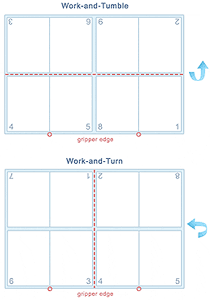Glossary
Glossary
Choose a topic:
Adhesive Materials
Adhesive Tape – An adhesive invention which let to a material coated with a sticky adhesive to hold two surfaces together.
Adhesion – Adhesion is what develops between two dissimilar bodies when they are in contact. At the molecular level, adhesion is based on physical and some chemical bonding. The strength of adhesion depends on the type of adhesive.
Aging Resistance – Under certain conditions, a degree of reliable performance of the tape occurs over time.
Backing (or Carrier) Material – The backing material carries the adhesive, reinforces PSA tape, and improves handling and processing properties. The most common types are:
- Film backings (e.g. PET, PP, PVC, PE)
- Paper-based backings (e.g. non-woven, tissue)
- Foam backings (e.g. PU-, PE- PVC-foams)
Cohesion – The inner strength of the adhesive that determines the holding power of the tape.
Conformability – When the backing of the tape influences its effect to adhere to a surface that is rough, curved or irregular.
Edge picking – An unwanted effect of the unwinding behavior of a roll of tape. This is caused by oozing of soft adhesives.
Fish eyes – When air is trapped between the roll’s layers, an optical effect is created.
Flame treatment – A method for modifying the surface of a substrate with a flame to provide a better bond for adhesive to a non-polar backing.
Hand tearable – Property of tapes which allows manual tearing or cutting without the use of a knife, scissors or dispenser. Both liner and backing must be tearable.
Liner – A material that is anti-adhesive and covers the adhesive on a double sided tape. The liner prevents the adhesive from sticking to itself. The liner is used as a protection aid during handling/processing and storage. Commonly used liners are:
- Paper liners (e.g. Glassine paper, PE-coated paper, Clay-coated paper)
- Film liners (e.g. PP, PET, PE) Usually, silicone is used as a release system to avoid adhesion between liner material and adhesive.
Migration – A molecular movement takes place when surfaces are in contact over a long period of time. Migration may occur between tape components and the surface to which it is applied. Some plastic films, like PVC, contain plasticizers, which are appropriate to migrate into the tape adhesive, allowing the adhesive to soften.
Oozing – When a softening adhesive is “squeezing out” at the edge of the tape.
Outgassing – The evaporating of chemical ingredients found in the adhesive (e. g. monomer residues, solvents, etc.) especially under elevated temperature conditions.
Peel Adhesion – The force needed to remove a pressure sensitive adhesive-coated material from it’s applied surface.
Plasticizer Resistance – The ability of a pressure sensitive tape to maintain it’s form under the influence of a plasticizer. When in contact with a plasticizer, the adhesive performance of a tape can be affected, especially with rubber-based adhesives.
Primer – A coating, like a backing or a substrate, which is applied to a surface prior to the application of an adhesive. This improves the bond performance between the tape and the substrate or between the backing and the adhesive.
PSA – Stands for Pressure Sensitive Adhesive Tape.
Release Force – The amount of force needed to remove a liner from the covered adhesive layer of double-sided tape. Release agents, like silicone, can change the release force.
Shear Resistance –The amount of force required to pull the adhesive material parallel to the surface to which it was affixed under specific conditions. The shear resistance of pressure-sensitive tape may be measured statically or dynamically. Static shear test methods use a constant load of longer test times. Dynamic shear tests measure the cohesion of the sample in a tensile tester under increasing force or load.
Stripping - the removal of the matrix or waste material from around a pressure sensitive label after it has been die cut.
Surface Energy – a term used to describe the surface of a given substrate. The molecular force of attraction between unlike materials determines their adhesion. The strength of attraction depends on the surface energy of the substrate. High surface energy means a strong molecular attraction, while low surface energy means weaker attractive forces.
Substrate – The material the tape is applied to.
Tack – Also known as “wet grab” or “quick stick”. It is the contact behavior of the adhesive to the substrate under a minimum of time and pressure.
Tensile Strength – The force required to break the adhesive material and/or the adhesive foam.
What Should You Consider in Making the Proper PSA Tape Choice?
- What is the material/substrate the adhesive will be sticking to?
- What are the conditions the tape will be exposed to, Temperature, Moisture, UV, Chemicals?
- What is the function of the PSA?
- How will the PSA be applied?
- Is it a permanent or temporary application?
Paper
Brightness - Refers to the percent of light reflected back from a sheet of paper as measured by a light meter reading. Contrast is reduced and highlights are not as strong when paper with lower brightness.
C1S paper - Paper coated one side. Not to be confused with UV and aqueous coatings or laminates, the terms C1S and C2S refer to paper coated at the manufacturing stage, prior to printing. Coated paper has a smoother printing surface and lower ink absorption than uncoated paper.
C2S paper - Paper coated on two sides.
Card Stock - Also called cover stock. Mostly heavyweight papers are called cards stock. The thickness of card stock is indicated with point sizes such as 14pt, 16pt. Some people will also refer to 100lb Cover as card stock.
Gloss Paper - Paper with a gloss finish, usually used for higher quality printing. Examples are 100lb gloss book, and 100lb gloss cover.
Paper Grain- The direction in which the fibers line up during the manufacturing process. It is easier to fold, bend, or tear the paper along the same direction of the fibers. Cut sheet laser printers generally use long grain paper in which the grain runs parallel to the long side of the paper, resulting in better performance through the laser printer.
Mailing
Bulk Mail - Standard Mail or Third Class Mail.
Barcode - A series of vertical bars and spaces that represent any numerical series, most often a correct ZIP Code for the delivery address on a mailpiece. The barcode facilitates automated processing by barcode readers and scanners. A barcode also can be used to convey information for Delivery Confirmation and Signature Confirmation services. Barcodes that may be used for postal processing are POSTNET and UCC/EAN Code 128.
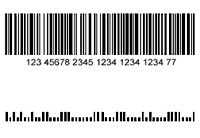
Bulk Mail- Standard Mail or Third Class Mail.
Carrier Route - The address to which a carrier delivers mail. In common usage, carrier route includes city routes, rural routes, highway contact routes, post office box sections, and general delivery units.
Coding Accuracy Support System (CASS) - A service offered to mailers, service bureaus, and software vendors that improves the accuracy of matching to delivery point codes, ZIP+4 codes, 5-digit Zip Codes, and carrier route codes on mail piece. CASS provides a common platform to measure the quality of address matching software and to diagnose and correct software problems.
Collect on Delivery (COD) - A service for mailers who need to mail an article for which they have not received payment. The amount due the sender is collected from the addressee and the USPS returns the amount due to the sender.
Direct Mail: - Another name for advertising mail sent to targeted markets. It can be any mail class, but it is usually Standard Mail.
Line-of-Travel (LOT) Sequence - A sequence required for some Enhanced Carrier Route and carrier route rates in which mail pieces are arranged by ZIP+4 codes in the order in which the carrier serves the route. The mail pieces are sequenced in delivery order.
Postage - Payment for delivery service that is affixed or imprinted to a mail piece, usually in the form of a postage stamp, permit imprint, or meter stamp.
Permit - Authorization required to mail without affixing postage. A postage imprint, also referred to as an indicia (The imprinted area in the upper right corner of the mail piece that indicates postage payment), is used instead. An advance payment is made to the post office and postage payment is deducted from that deposit.
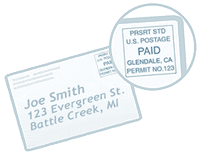
Presort - The process by which a mailer groups mail by ZIP Code so that it is sorted to the finest extent required by the standards for the rate claimed. Generally, presort is performed sequentially, from the lowest (finest) level to the highest level, to those destinations specified by standard and is completed at each level before the next level is prepared. Not all presort levels are applicable to all mailings.
Sleeve - A paperboard jacket that fits over the four sides (top, bottom, and two parallel sides) of a letter tray in order to keep the mail inside the tray from falling out.
Tray - A container used in postal facilities to hold letters and First-Class Mail flats. It is used as a basic unit of mail quantity for purposes of preparing mail to a qualify for discounted postage rates. Also see full flat tray, full letter tray, less-than-full tray, and overflow tray.
ZIP Code - A system of 5-digit codes that identifies the individual post office or metropolitan area delivery station associated with an address. ZIP+4 is an enhanced code consisting of the 5-digit ZIP Code and four additional digits that identify a specific range of delivery addresses.
ZIP+4 Code - A nine digit numeric code composed of two parts: (a) the initial code: the first five digits that identify the sectional center facility and delivery area associated with the address, followed by a hyphen; and (b) the four-digit expanded code: the first two additional digits designate the sector (a geographic area) and the last two digits designate the segment (a building, floor, etc.)
ZIP+4 barcode - A nine-digit POSTNET barcode consisting of 52 vertical bars. Also see Postal Numeric Encoding Technique.
Printing Process and Finishes
Batch - We have two different batch sizes 28" x 20" or 40" x 28". Jobs with the same type and quantity are collected on the same batch. For example, all business cards and postcards 4/1 1k are collected and printed on the same batch.
Bindery - The finishing department, which performs operations on the printed product after it has been printed. The bindery operations are as follows: Folding, Binding, Stitching, Scoring, Perforation, Die Cutting, & Envelope Converting (currently done in house).
Binding - Different methods used to secure loose pages in a book is called binding. Saddle stitch is an example of binding.
Bleed - Bleed must extend past the cut-line and will be trimmed from the product during the final cutting phase. When the image is required to extend all the way to the edge, bleed is needed to preserve the finished look and the quality of the final product.
- The bleed for Standard Products is 0.125".
- The bleed for Booklets and Presentation Folders is 0.25".
CMYK - The primary colors used in 4-color printing. CMYK are used to reproduce full color on the printed sheet. CMYK also called PROCESS COLOR
C: Cyan (Blue)
M: Magenta (Red)
Y: Yellow
K: Key (Black)
Coating - The mixture of clay materials that are applied to paper to improve the smoothness of the paper's surface and improve ink holdout during the printing process. Examples are Aqueous coating (AQ) and UV coating. UV coating adds a gloss finish to the product and also improves the vibrancy of the printed colors. Spot-UV can be applied to selected portions of the piece, while keeping the rest a matte finish.
Collecting - Prepress Department that imposes multiple jobs of the same type in a press layout, called a batch. Collecting is responsible for creating schedules that meet production deadlines and satisfy job turnarounds.
Color Types
0:4 (0 over 4) - 1 sided
full color
4:4 (4 over 4) - 2 sided
full color on front and on back
4:1 (4 over 1) - 2 sided
full color on front, black on back
4:0 (4 over 0) - 1 sided
full color on front
5:0 (5 over 0) - 1 sided
full color + foil on front
5:1 (5 over 1) - 2 sided
full color with foil on front, black on back
4:5 (4 over 5) - 2 sided
full color on front and full color with foil on back
5:4 (5 over 4) - 2 sided
full color with foil on front and full color on back
5:5 (5 over 5) - 2 sided
full color with foil on front and on back
Crop Marks (Guide Marks) - Lines printed in the margin of sheet that indicates to the cutter and bindery where the finished product should be trimmed. They are also used to show what part of a photo should be used and what part should be cropped off.
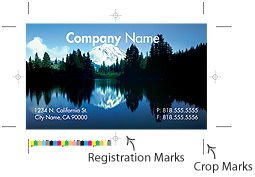
Die Cutting - A specific shape like circle, star, etc (any designs that cannot be done by a straight cut) which is cut by a metal blade. Door hangers are a popular product that requires die-cutting.
Dots Per Inch (dpi) - A measurement of resolution of input, output, and display devices. 300 dpi means that when printed, each square inch of your image will contain 90,000 pixels (dots), the higher the dpi (the more pixels per inch) the more crisp the printed image will be.
Finished Size / Trim Size - The size of a printed product after all production operations have been completed.
Finishing - Operations to a document after it has been printed. The finishing operations could include bindery work such as folding, trimming, binding, die-cutting, inserting, or any post press process that must be completed.
Flat Size - The size of a printed product after printing and trimming but before any finishing operations that affect its size, such as folding.
Foil - The application of metallic gold or silver foil on paper using a heated die. The foil is adhered to the surface leaving the design of the die on the paper. Our Foil Stamp Printing adds a custom touch to your printed product by applying a thin film of metal to paper that creates a high-grade, eye-catching result.
Folding - The process of bending printed sheets in a specific area. Folding is one of our popular bindery jobs.
Full Bleed - Printing that goes to the edge of all four sides of the page.
Gloss Finish - A coating on paper that provides a higher reflection of light, which results in a shiny appearance. Gloss coatings reduce ink absorption, which allows excellent contrast and color definition.
Grippers - Metal finger like clamps that grab the paper to pull it through the press as the sheet is being printed.
Hairline - The thinnest possible line or space that is visible.
Head to Head - Printing on the front and back of a sheet is setup so that the top of both sides is printed at the same end of the sheet. You would turn the sheet like the page of a book to read the reverse side.
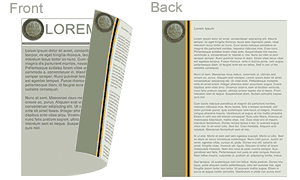
Head-to-Toe - Printing on the front and back of a sheet so that the tops of each side are printed at opposite ends from each other. The top of one side is opposite the bottom of the other. You would turn the sheet over from top to bottom to read the reverse side. Also referred to as head-to-tail or tumble.
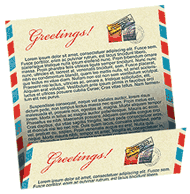
Hickey - A spot on a printed sheet that appears as a small white circle with ink in the center, caused by particles such as dirt, dust, or bits of paper.
Imprinting - The printing of new copy on a piece that is already printed. Examples of imprinting are ink-jetting addresses on postcards after the actual card has been printed. Sellers usually DO NOT imprint or inkjet on any paper with AQ or UV Coating. The only job that can be imprinted after printing is spot UV jobs and any jobs in this category, which are as follows: Spot UV on both sides, UV one side no UV on the other side, Spot UV on one side no UV on the other side. These jobs do not get UV or AQ coating after imprinting.
In House - When a production process for a printed product is done within a facility and is not sent to an outsider, also referred to as in plant.
Ink Jet - A printing technology in which liquid ink is sprayed through tiny nozzles onto the paper in a pattern of dots, forming the image on the paper. Jobs with AQ or UV coating cannot be ink jet printed.
Insert - A letter, card, or similar item placed inside another mail piece (host piece).
Job Number - A unique number assigned to a job by a buyer or manufacturer. The number allows the job to be tracked throughout production. On Collllor, customers get job numbers automatically when they place an order.
Lamination - The process of applying a film, often plastic or copolymer, to either one or both sides of a printed sheet. Lamination adds a gloss or silk finish to a printed product and provides durability, water resistance and tear resistance.
Gloss Lamination: A high gloss film applied to one or both sides of a print product. Gloss lamination is optically clear, durable and is scuff, tear and water resistant.
Silk Lamination: A dull matte film applied to one or both sides of a print product. Silk lamination give cards a luxurious smooth feel and may dull color and contrast slightly. Durable Silk lamination is tear and water resistant.
Landscape - Printing a page so that when positioned for reading the width is greater than the height.
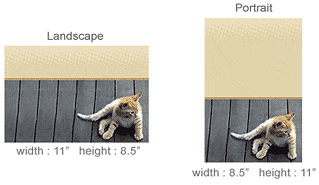
Line Screen - A transparent screen that has been etched with fine lines. It is used to convert a picture or photograph into a halftone dot pattern so that can be printed.
While printing 200 lpi may be satisfactory, some sellers adopt FM screening method that brings near photographic quality. FM eliminates halftone screen angles while preserving the desirable details in your artwork. FM screening process employs 20-micron dot size which is equivalent to 500 lpi.
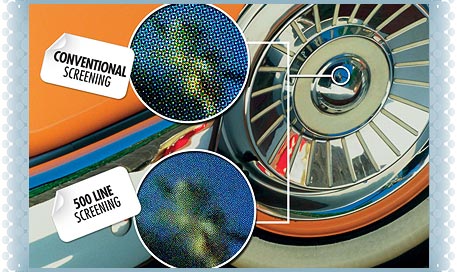
Make-Ready - 1.The process of setting up and adjusting a printing press for a particular ink, paper and specifications prior to printing. This includes adjusting the infeed, grippers and guides, adjusting ink for proper coverage, registering copy, and matching the printed piece with the proof to be sure everything is correct. Also referred to as set up. 2. The paper used while making all the necessary adjustments before printing the actual run. Also referred to as set up.
Margin - The non-printed areas around the image area of a page.
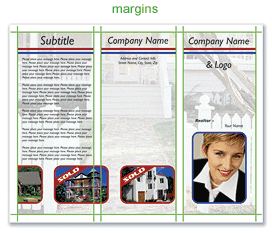
Offset Printing - The transfer of an inked image from a plate to a blanket cylinder, which in turn transfers the image to the printing material as it passes between the blanket and the impression cylinder and pressure is applied. Also referred to as offset lithography.
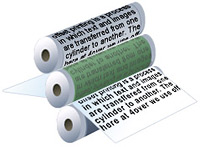
Out of Register / Off Register - When an image is not printing in the exact location that it is supposed to. When printing more than one color, if the colors do not line up properly, they are out of register.
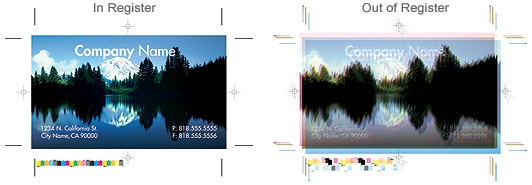
Output - Sending information from a computer to a printing device to produce a printed page is called output.
Overprinting - Printing an image over an area that has already been printed. In printing process colors, one process color is printed over another creating a secondary color, which is a combination of two primary colors.
Overruns / Overs - The number of items produced over the quantity that was originally ordered. Also referred to as any paper spoiled in the process of printing. For example, if the seller's batch is 1000 quantity batch they may overrun 150-200 sheets.
Pantone Matching System (PMS) - A registered name for an ink color matching system used to compare, match and identify specific colors. To do so we use a pantone book. It contains pantone colors with their closest CMYK values.
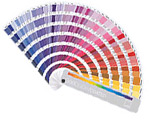
Perfector - A printing press that can print on the front and the back of the paper in one pass through the press.
Perfecting - The process of printing both sides of a sheet of paper in the same pass through the press.
Pixel - The smallest unit of a digitized image created by a digital device, such as a computer, camera, or scanner. Pixel is short for "picture element." The more pixels per inch the better the resolution. On computer monitors, the display is divided into rows and columns containing thousands or millions of pixels. Each pixel is composed of three dots representing the three color channels of red, green, and blue light that are necessary for creating a color image on computer monitors and television screens. Because of their small size, the pixels appear to merge, simulating a continuous tone image, but when magnified they appear to be tiny square blocks of light, as shown in the illustration.
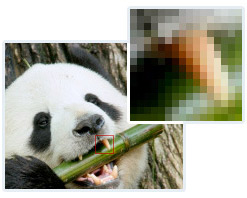
Plate - A metal or paper light-sensitive sheet that holds an image that has been photographically produced. During the printing process, the image area picks up ink, which is then transferred to a blanket and then to paper.
Press Check - Printed sheets from the press that are pulled once all the makeready has been completed. The sheets are checked for quality and accuracy before an authorization is given to go ahead with the full production run. Sheets may be pulled throughout the run to do press checks to assure that quality is being maintained.
Press Proof - A proof that is produced on the press using the inks and paper specified for that order.
Press Run - The total quantity of pieces printed during one printing.
Price Break - The order quantity level at which the price of the paper or printed material goes down.
Processing - The department in charge of making customers' files "print ready".
Proofs - A copy of the artwork representing the finished product. It is used for review and approval. On Collllor, you can select the proof in your cart. The list will show all types of proofs that are available from the seller.
Proofread - Checking a proof for errors or discrepancies from the original copy.
Quotation - A price, given by the seller, based on the specifications supplied for that product. Collllor automates the quotation process, but the seller may suggest other options and change the price based on the job specifications.
Register Marks - The printed marks used to align color separations for printing so that each color registers with each other.
Resolution - The measurement of output quality expressed in pixels (dots) per inch on a computer monitor or dots per inch on printed media. For example, a monitor displaying a resolution of 800 by 600 refers to a screen capable of displaying 800 pixels in each of 600 lines, which translates into a total of 480,000 pixels displayed on the screen. When referring to printed media, a 300 dpi (dots per inch) printer, for example, is capable of outputting 300 dots in a one-inch line, which means that it has the ability to print 90,000 distinct dots per square inch (300 x 300).
RGB - The additive primary colors, red, green and blue, used to display color in video monitors. Printing with a file in RGB color mode will produce a washed out appearance. 4over does not check files for RGB. That responsibility falls to the customer before submission of the files.
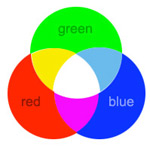
Rotation - The turning or positioning of text or an image at different degrees of orientation on a page.
Scoring - A crease applied, in a straight line, to a sheet of paper to allow it to fold easier and more accurately.
Set Up - 1.The process of setting up and adjusting a printing press for a particular ink, paper and specifications prior to printing. This includes adjusting the infeed, grippers and guides, adjusting ink for proper coverage, registering copy, and matching the printed piece with the proof to be sure everything is correct. 2. The paper used while making all the necessary adjustments before printing the actual run. Also referred as Make-Ready.
Skid / Pallet - A wooden platform used to hold stacks of paper or cartons. Used to store or ship materials or finished products.
Slitting - Cutting paper by the use of a cutting wheel. Paper may be slit into smaller sheets or a web of paper may be slit into narrower rolls.
A slit can also refer to cuts made that do not divide a sheet. For example, on a presentation folder smaller diagonal slits can be made on the pockets where business cards can then be displayed.
Spot Color - Printing with one or more solid colors, generally black ink is used with the addition of other colors. It is used to add highlight and add color to a printed product without having to print with a four-color process.
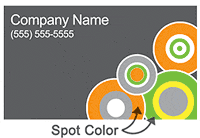
Swatch Book - A booklet containing samples of paper or ink colors.

Template - A preset model that acts as a structure for setting up a similar product. On Collllor Sellers may offer their templates for the stock products.
Trim -
1. The process of cutting the product to its finished size. The excess that is cut off is also referred to as the trim.
2. Combining various roll sizes to be slit from a full width roll from the paper machine so that an acceptable percentage of the salable width will be used.
Turnaround Time - The accumulated time between receipt of an order and completion of the finished product.
Typesetting - The process of converting text into type used for printing.
Ultraviolet - The part of the spectrum where the wavelength of light is shorter than the wavelength of visible light.
UV Coating - A liquid coating applied to the printed piece, which is then bonded and cured with ultraviolet light. This coating is used to provide a protective coating to the printed image. Please note that you CAN NOT write or imprint on a uv coated jobs.
Varnish - A thin, liquid protective coating, either matte or glossy, that is applied to the product. It adds protection and enhances the appearance of the product. It can be applied as an all over coating or it can be applied as a spot coating.
Vendor - The provider of a product or service. Also referred to as supplier or Seller.
Zip - Zipping is a way to compress electronic files A compressed file is considered "zipped."
Printing Types
Stochastic Screening - Images are converted digitally into screens made up of very small dots which are equal in size, but of variable spacing. The variable dot pattern eliminates many of the moiré patterns and allows for more than four colors to be used to represent an image. This is the primary aspect of high-fidelity printing.
Work and Tumble- A printing method where different pages are assembled so that they are on one plate. One side is printed and the sheet is turned from front to rear so that you are using the opposite edge as the gripper edge and then the second side is printed. The product is then cut apart to make two finished items.
Work and Turn - A printing method where different pages are assembled so that they are on one plate. One side is printed and then the sheet is turned over so that you are using the same gripper edge and then the second side is printed. The product is then cut apart to make two finished items.
